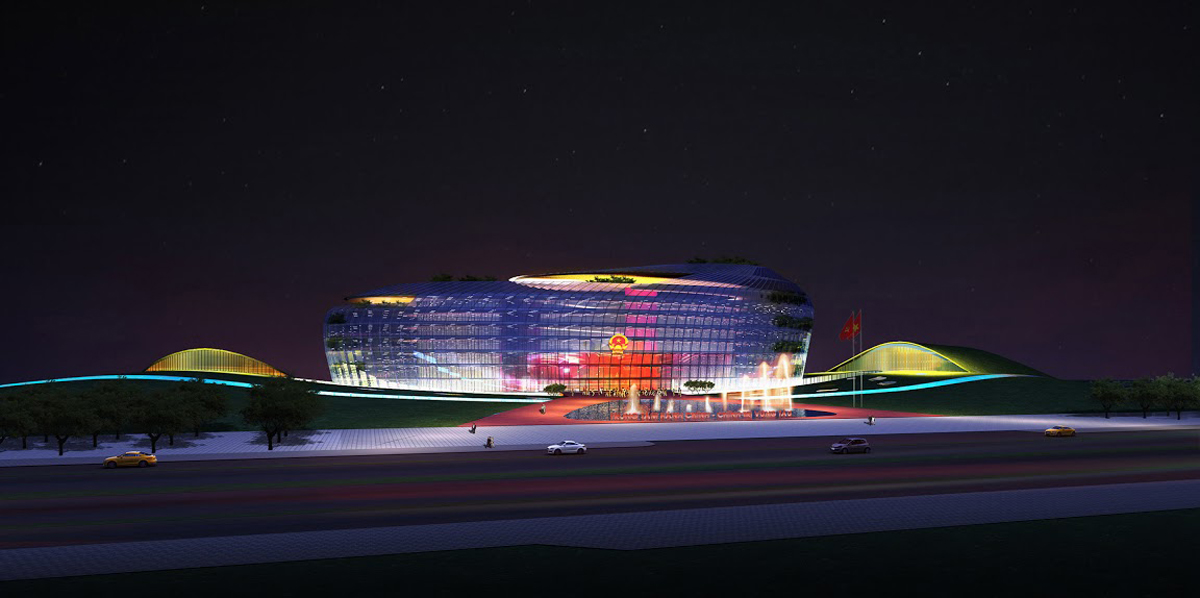Tel Aviv Museum of Art opens its new Herta and Paul Amir Building tomorrow

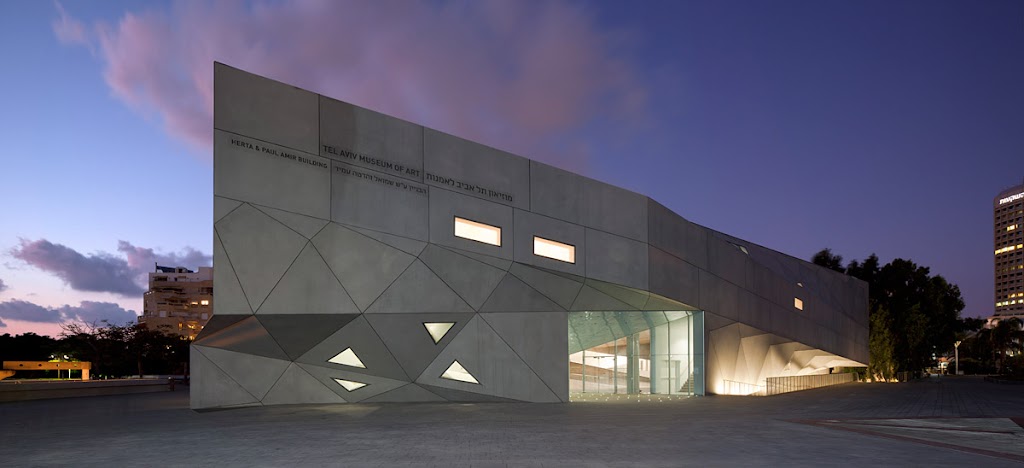






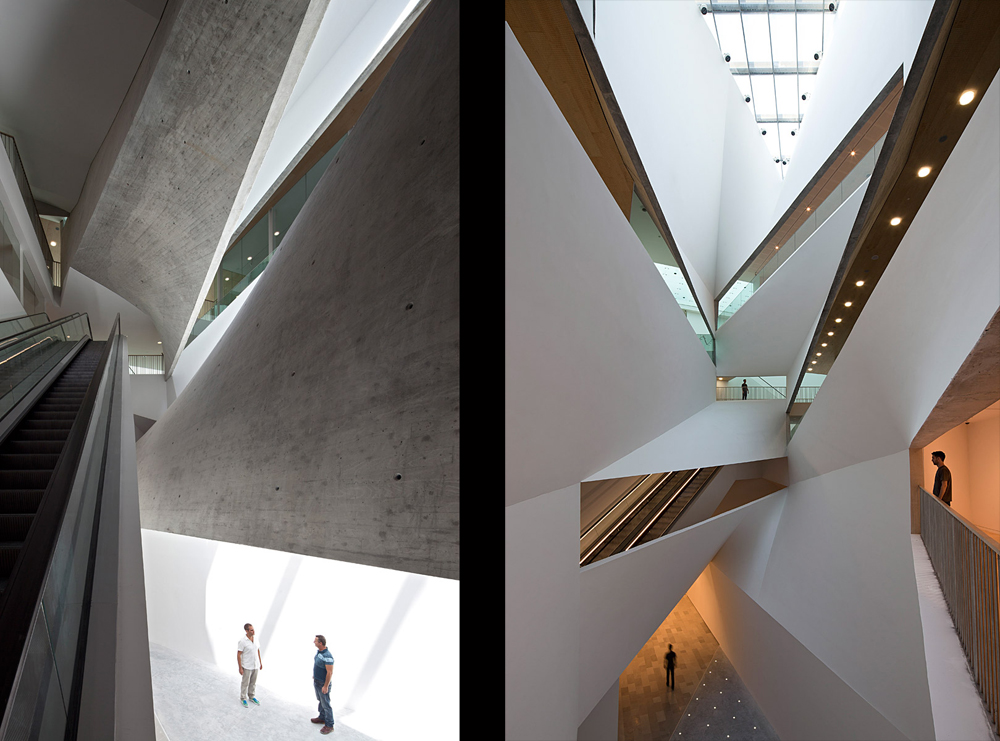

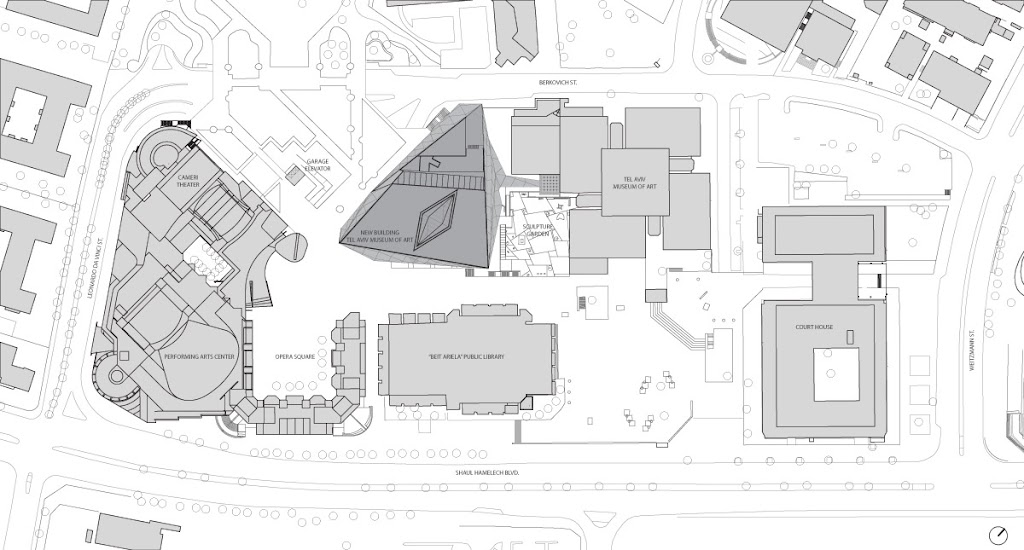
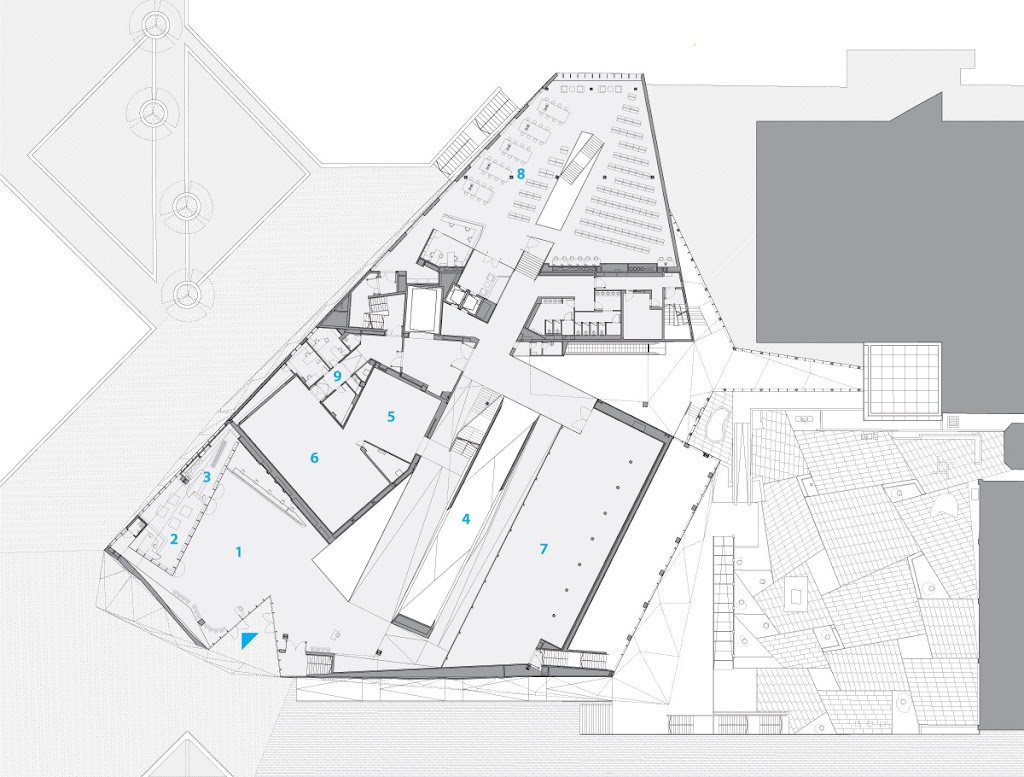
















 Architects: Preston Scott Cohen, Inc
Location: Tel Aviv, Israel
Project Area: 200,000 sqf
Project Year: 2007-2011
Photographer: Amit GeronDesigned by Preston Scott Cohen, Inc., of Cambridge, Massachusetts, the freestanding concrete-and-glass building is a tour de force of complex geometry and light-filled space. Outside, the gleaming and angular Amir Building establishes a dialogue with the Museum’s existing building and the renowned modern architecture of Tel Aviv, with its traditions of Mendelsohn, the White Bauhaus City. On the inside, the Amir Building reveals that it is built around a spiraling, top-lit, 87-foot-high atrium known as the “Lightfall”, whose subtly twisting surfaces curve and veer up and down through the structure.
There are five levels to the building—two above grade and three below—which twist from floor to floor, to accommodate large, rectangular galleries within the compact, nearly triangular site. The stairs and ramped promenades of the Lightfall serve as the surprising, continually unfolding vertical circulation through these floors, connecting the disparate angles of the galleries and allowing natural light to refract into the deepest recesses of the half-buried building.
“We are immensely pleased to be able to add much-needed space to our facilities while making an exciting and important contribution to the landscape of our city,” stated Professor Mordechai Omer, Director and Chief Curator of the Tel Aviv Museum of Art. “I believe the Israeli public and visitors from around the world will share our excitement. As if in a single gesture, Preston Scott Cohen’s building is startling and original and yet beautifully practical as a setting for our works of art.”
The Amir Building houses 18,500 square feet of gallery space for the Museum’s comprehensive collection of Israeli art. A selection of some 250 of these works will be on view in the inaugural installation, dating from 1906 to the present. Also on view in the permanent collection galleries of the Amir Building during the opening period will be:
Architects: Preston Scott Cohen, Inc
Location: Tel Aviv, Israel
Project Area: 200,000 sqf
Project Year: 2007-2011
Photographer: Amit GeronDesigned by Preston Scott Cohen, Inc., of Cambridge, Massachusetts, the freestanding concrete-and-glass building is a tour de force of complex geometry and light-filled space. Outside, the gleaming and angular Amir Building establishes a dialogue with the Museum’s existing building and the renowned modern architecture of Tel Aviv, with its traditions of Mendelsohn, the White Bauhaus City. On the inside, the Amir Building reveals that it is built around a spiraling, top-lit, 87-foot-high atrium known as the “Lightfall”, whose subtly twisting surfaces curve and veer up and down through the structure.
There are five levels to the building—two above grade and three below—which twist from floor to floor, to accommodate large, rectangular galleries within the compact, nearly triangular site. The stairs and ramped promenades of the Lightfall serve as the surprising, continually unfolding vertical circulation through these floors, connecting the disparate angles of the galleries and allowing natural light to refract into the deepest recesses of the half-buried building.
“We are immensely pleased to be able to add much-needed space to our facilities while making an exciting and important contribution to the landscape of our city,” stated Professor Mordechai Omer, Director and Chief Curator of the Tel Aviv Museum of Art. “I believe the Israeli public and visitors from around the world will share our excitement. As if in a single gesture, Preston Scott Cohen’s building is startling and original and yet beautifully practical as a setting for our works of art.”
The Amir Building houses 18,500 square feet of gallery space for the Museum’s comprehensive collection of Israeli art. A selection of some 250 of these works will be on view in the inaugural installation, dating from 1906 to the present. Also on view in the permanent collection galleries of the Amir Building during the opening period will be:
- an installation of Israeli photography of the past twenty years;
- a series of two consecutive exhibitions, Utopias of Expressionism and Cure by Expression, showing the strength of the collection of prints and drawings;
- two installations of work by leading Israeli designers, Library by Chanan DeLange and Circle by Yaakov Kaufman;
- and an exhibition documenting the design of the five buildings of the Tel Aviv Museum of Art, from the original Dizengoff House to the Amir Building, organized by guest curators Jascha Grobman and Ariel Blonder.
To inaugurate its new 9,000-square-foot temporary exhibitions gallery in the Amir Building, the Museum will present Kiefer in Tel Aviv, a site-specific exhibition organized by Mordechai Omer in collaboration with the artist. Large-scale works by Kiefer inspired by themes of the Hebrew Bible, Jewish myths and mysticism and German-Jewish history will surround two of the artist’s monumental enclosures: East-West, housing 44 huge metal plates imprinted with images of paintings and objects, and a specially conceived version of The Library, whose multiple pewter and lead “books” are a record of diagrams and photographs.
Among its other facilities, the Amir Building provides a new 7,000-square-foot auditorium, allowing the institution to expand the busy schedule of film screenings, music performances, readings, lectures and discussion programs that make the Tel Aviv Museum of Art an indispensable center of activity for the city’s artistic and cultural community. Today, November 1, the auditorium is the venue for a
Speaking about his design for the Amir Building, Preston Scott Cohen stated, “The Museum’s program set the challenge of providing several floors of large, neutral, rectangular galleries within a tight, idiosyncratic, triangular site. The solution we proposed was to ‘square the triangle’ by constructing the levels on different axes, which deviate significantly from floor to floor and are unified by the Lightfall. This decision enabled us to combine two seemingly irreconcilable paradigms of the contemporary art museum: the museum of neutral white boxes, which provides optimal, flexible space for the exhibition of art, and the museum of spectacle, which moves visitors and offers a remarkable social experience. In this way, the Amir Building’s synthesis of radical and conventional geometries produces a new type of museum experience, one that is as rooted in the Baroque as it is in the Modern.”
Ron Huldai, Mayor of the Municipality of Tel Aviv, commented, “We see the opening of the Amir Building as a landmark moment to inaugurate our Tel Aviv Global City initiative, a strategic plan that follows an investment of $250 million in our cultural and historical institutions over the past decade. To make Tel Aviv Global City a part of everyone’s life from the very beginning, we will launch The Year of Art in September 2011. The city will present a calendar of dozens of exhibitions, conferences, community projects, educational initiatives and festivals, many of them with international partners—and as the centerpiece, we will celebrate the opening of the Herta and Paul Amir Building.”
Paul Amir, the Los Angeles-based real-estate developer and philanthropist who with his wife Herta provided the naming gift for the building, stated, “We feel privileged to have been able to advance the work of the Tel Aviv Museum of Art, an institution that is truly at the heart of Israel’s creative community. With this exceptional building by Preston Scott Cohen, and with the ability to showcase the work of Israel’s artists as never before, the Museum now has the potential to step up to a prominent new role on the international scene, to the benefit of everyone.”
The architectural competition for the Herta and Paul Amir Building was conducted in the first half of 2003. Design development began in 2005, and the groundbreaking was held in 2007.
The Museum campus is located in the heart of Tel Aviv, immediately adjacent to the Golda Meir Cultural & Art Center (with the New Israeli Opera and the Cameri Theater) and the Beit Ariela Municipal Library. The existing main building, a 175,000-square-foot structure by Dan Eytan and Yitzchak Yashar, opened in 1971 and was expanded with an 11,300-square-foot Sculpture Garden (opened 1996) and the 32,300-square-foot Gabrielle Rich Wing (Dan Eytan, 1999).
When the Amir Building opens tomorrow, galleries in the main building that were previously used for Israeli art, photography, video, and design and architecture will be dedicated to the Museum’s extensive program of changing exhibitions. The central Sam and Ayala Zacks Gallery in the main building, previously used for changing exhibitions , will now be dedicated to an installation from the permanent collection of European and American art from the era after World War II.
Find plans and drawings of the building in the image gallery below. For an in-depth ShowCase feature, including additional photographs, head over to our sister site
Related: preston scott cohen + namit nemlich: tel aviv museum expansion
Source: Preston Scott Cohen, Inc./ www.bustler.net milimetdesign – Where the convergence of unique creatives




























 Architects: Preston Scott Cohen, Inc
Location: Tel Aviv, Israel
Project Area: 200,000 sqf
Project Year: 2007-2011
Photographer: Amit GeronDesigned by Preston Scott Cohen, Inc., of Cambridge, Massachusetts, the freestanding concrete-and-glass building is a tour de force of complex geometry and light-filled space. Outside, the gleaming and angular Amir Building establishes a dialogue with the Museum’s existing building and the renowned modern architecture of Tel Aviv, with its traditions of Mendelsohn, the White Bauhaus City. On the inside, the Amir Building reveals that it is built around a spiraling, top-lit, 87-foot-high atrium known as the “Lightfall”, whose subtly twisting surfaces curve and veer up and down through the structure.
There are five levels to the building—two above grade and three below—which twist from floor to floor, to accommodate large, rectangular galleries within the compact, nearly triangular site. The stairs and ramped promenades of the Lightfall serve as the surprising, continually unfolding vertical circulation through these floors, connecting the disparate angles of the galleries and allowing natural light to refract into the deepest recesses of the half-buried building.
“We are immensely pleased to be able to add much-needed space to our facilities while making an exciting and important contribution to the landscape of our city,” stated Professor Mordechai Omer, Director and Chief Curator of the Tel Aviv Museum of Art. “I believe the Israeli public and visitors from around the world will share our excitement. As if in a single gesture, Preston Scott Cohen’s building is startling and original and yet beautifully practical as a setting for our works of art.”
The Amir Building houses 18,500 square feet of gallery space for the Museum’s comprehensive collection of Israeli art. A selection of some 250 of these works will be on view in the inaugural installation, dating from 1906 to the present. Also on view in the permanent collection galleries of the Amir Building during the opening period will be:
Architects: Preston Scott Cohen, Inc
Location: Tel Aviv, Israel
Project Area: 200,000 sqf
Project Year: 2007-2011
Photographer: Amit GeronDesigned by Preston Scott Cohen, Inc., of Cambridge, Massachusetts, the freestanding concrete-and-glass building is a tour de force of complex geometry and light-filled space. Outside, the gleaming and angular Amir Building establishes a dialogue with the Museum’s existing building and the renowned modern architecture of Tel Aviv, with its traditions of Mendelsohn, the White Bauhaus City. On the inside, the Amir Building reveals that it is built around a spiraling, top-lit, 87-foot-high atrium known as the “Lightfall”, whose subtly twisting surfaces curve and veer up and down through the structure.
There are five levels to the building—two above grade and three below—which twist from floor to floor, to accommodate large, rectangular galleries within the compact, nearly triangular site. The stairs and ramped promenades of the Lightfall serve as the surprising, continually unfolding vertical circulation through these floors, connecting the disparate angles of the galleries and allowing natural light to refract into the deepest recesses of the half-buried building.
“We are immensely pleased to be able to add much-needed space to our facilities while making an exciting and important contribution to the landscape of our city,” stated Professor Mordechai Omer, Director and Chief Curator of the Tel Aviv Museum of Art. “I believe the Israeli public and visitors from around the world will share our excitement. As if in a single gesture, Preston Scott Cohen’s building is startling and original and yet beautifully practical as a setting for our works of art.”
The Amir Building houses 18,500 square feet of gallery space for the Museum’s comprehensive collection of Israeli art. A selection of some 250 of these works will be on view in the inaugural installation, dating from 1906 to the present. Also on view in the permanent collection galleries of the Amir Building during the opening period will be:






























